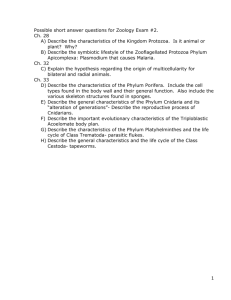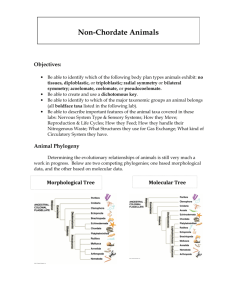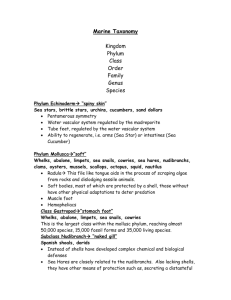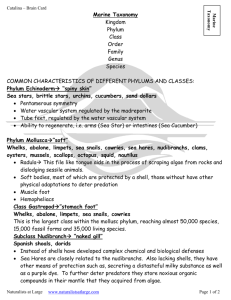Invertebrate Phylum Chart
advertisement
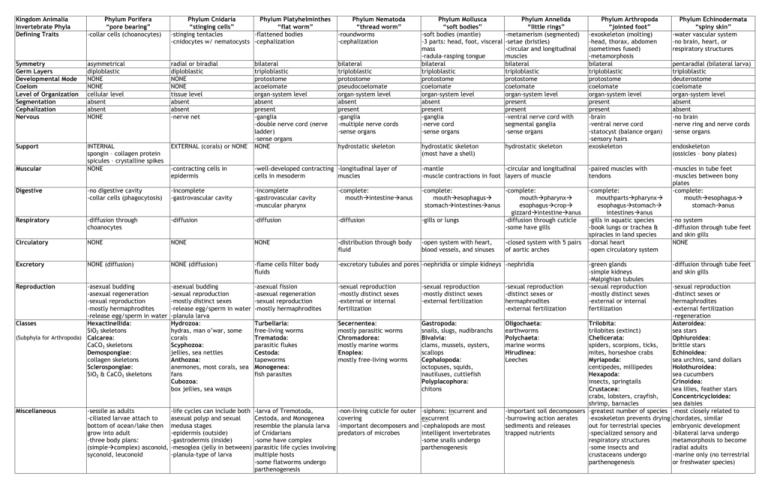
Kingdom Animalia Invertebrate Phyla Defining Traits Phylum Porifera “pore bearing” -collar cells (choanocytes) Phylum Cnidaria Phylum Platyhelminthes “stinging cells” “flat worm” -stinging tentacles -flattened bodies -cnidocytes w/ nematocysts -cephalization Phylum Nematoda “thread worm” -roundworms -cephalization Symmetry Germ Layers Developmental Mode Coelom Level of Organization Segmentation Cephalization Nervous asymmetrical diploblastic NONE NONE cellular level absent absent NONE radial or biradial diploblastic NONE NONE tissue level absent absent -nerve net bilateral triploblastic protostome pseudocoelomate organ-system level absent present -ganglia -multiple nerve cords -sense organs Support INTERNAL spongin – collagen protein spicules – crystalline spikes NONE EXTERNAL (corals) or NONE bilateral triploblastic protostome acoelomate organ-system level absent present -ganglia -double nerve cord (nerve ladder) -sense organs NONE -contracting cells in epidermis -well-developed contracting -longitudinal layer of cells in mesoderm muscles Digestive -no digestive cavity -collar cells (phagocytosis) -incomplete -gastrovascular cavity -incomplete -gastrovascular cavity -muscular pharynx -complete: mouthintestineanus Respiratory -diffusion through choanocytes -diffusion -diffusion -diffusion Circulatory NONE NONE NONE -distribution through body fluid Excretory NONE (diffusion) NONE (diffusion) -flame cells filter body fluids -excretory tubules and pores -nephridia or simple kidneys -nephridia -asexual budding -asexual regeneration -sexual reproduction -mostly hermaphrodites -release egg/sperm in water Classes Hexactinellida: SiO2 skeletons (Subphyla for Arthropoda) Calcarea: CaCO3 skeletons Demospongiae: collagen skeletons Sclerospongiae: SiO2 & CaCO3 skeletons -asexual budding -sexual reproduction -mostly distinct sexes -release egg/sperm in water -planula larva Hydrozoa: hydras, man o’war, some corals Scyphozoa: jellies, sea nettles Anthozoa: anemones, most corals, sea fans Cubozoa: box jellies, sea wasps -asexual fission -asexual regeneration -sexual reproduction -mostly hermaphrodites -sexual reproduction -mostly distinct sexes -external or internal fertilization -sexual reproduction -mostly distinct sexes -external fertilization Turbellaria: free-living worms Trematoda: parasitic flukes Cestoda: tapeworms Monogenea: fish parasites Secernentea: mostly parasitic worms Chromadorea: mostly marine worms Enoplea: mostly free-living worms Gastropoda: snails, slugs, nudibranchs Bivalvia: clams, mussels, oysters, scallops Cephalopoda: octopuses, squids, nautiluses, cuttlefish Polyplacophora: chitons Miscellaneous -life cycles can include both asexual polyp and sexual medusa stages -epidermis (outside) -gastrodermis (inside) -mesoglea (jelly in between) -planula-type of larva -larva of Tremotoda, Cestoda, and Monogenea resemble the planula larva of Cnidarians -some have complex parasitic life cycles involving multiple hosts -some flatworms undergo parthenogenesis -non-living cuticle for outer covering -important decomposers and predators of microbes -siphons: incurrent and excurrent -cephalopods are most intelligent invertebrates -some snails undergo parthenogenesis Muscular Reproduction -sessile as adults -ciliated larvae attach to bottom of ocean/lake then grow into adult -three body plans: (simplecomplex) asconoid, syconoid, leuconoid hydrostatic skeleton Phylum Mollusca “soft bodies” -soft bodies (mantle) -3 parts: head, foot, visceral mass -radula-rasping tongue bilateral triploblastic protostome coelomate organ-system level absent present -ganglia -nerve cord -sense organs Phylum Annelida “little rings” -metamerism (segmented) -setae (bristles) -circular and longitudinal muscles bilateral triploblastic protostome coelomate organ-system level present present -ventral nerve cord with segmental ganglia -sense organs Phylum Arthropoda “jointed foot” -exoskeleton (molting) -head, thorax, abdomen (sometimes fused) -metamorphosis bilateral triploblastic protostome coelomate organ-system level present present -brain -ventral nerve cord -statocyst (balance organ) -sensory hairs exoskeleton Phylum Echinodermata “spiny skin” -water vascular system -no brain, heart, or respiratory structures hydrostatic skeleton (most have a shell) hydrostatic skeleton -mantle -circular and longitudinal -muscle contractions in foot layers of muscle -paired muscles with tendons -complete: -complete: mouthesophagus mouthpharynx stomachintestinesanus esophaguscrop gizzardintestineanus -gills or lungs -diffusion through cuticle -some have gills -complete: mouthpartspharynx esophagusstomach intestinesanus -gills in aquatic species -book lungs or trachea & spiracles in land species -dorsal heart -open circulatory system -muscles in tube feet -muscles between bony plates -complete: mouthesophagus stomachanus -open system with heart, blood vessels, and sinuses -closed system with 5 pairs of aortic arches -sexual reproduction -distinct sexes or hermaphrodites -external fertilization -green glands -simple kidneys -Malpighian tubules -sexual reproduction -mostly distinct sexes -external or internal fertilization pentaradial (bilateral larva) triploblastic deuterostome coelomate organ-system level absent absent -no brain -nerve ring and nerve cords -sense organs endoskeleton (ossicles – bony plates) -no system -diffusion through tube feet and skin gills NONE -diffusion through tube feet and skin gills -sexual reproduction -distinct sexes or hermaphrodites -external fertilization -regeneration Oligochaeta: Trilobita: Asteroidea: earthworms trilobites (extinct) sea stars Polychaeta: Chelicerata: Ophiuroidea: marine worms spiders, scorpions, ticks, brittle stars Hirudinea: mites, horseshoe crabs Echinoidea: Leeches Myriapoda: sea urchins, sand dollars centipedes, millipedes Holothuroidea: Hexapoda: sea cucumbers insects, springtails Crinoidea: Crustacea: sea lilies, feather stars crabs, lobsters, crayfish, Concentricycloidea: shrimp, barnacles sea daisies -important soil decomposers -greatest number of species -most closely related to -burrowing action aerates -exoskeleton prevents drying chordates, similar sediments and releases out for terrestrial species embryonic development trapped nutrients -specialized sensory and -bilateral larva undergo respiratory structures metamorphosis to become -some insects and radial adults crustaceans undergo -marine only (no terrestrial parthenogenesis or freshwater species)

